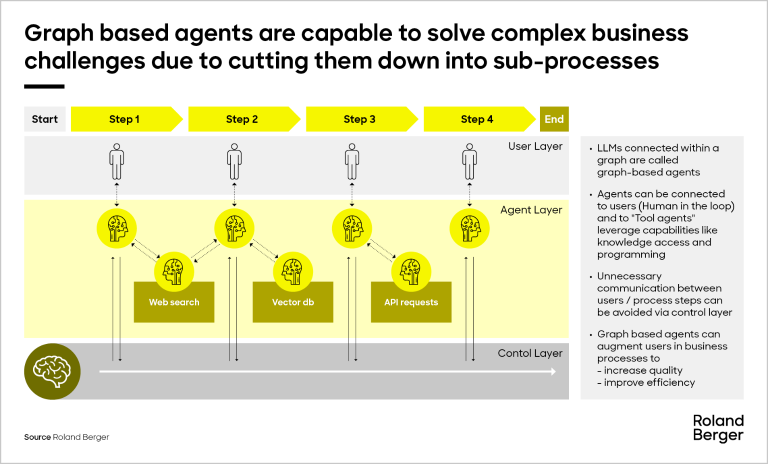Practical advice from Roland Berger on leveraging proprietary data management to gain a competitive advantage with generative AI.


Beyond automation: Why AI agents are your next strategic imperative
By Maria Mikhaylenko and Michael Schich
How sophisticated AI agents can unlock strategic advantage and drive transformation
The conversation around Artificial Intelligence is intensifying. Beyond the current focus on chatbots and generative models, a more fundamental transformation is taking shape: the rise of AI Agents. These are not merely tools for simple task automation; they are sophisticated, self-directed digital entities capable of complex reasoning, planning, and executing multi-step processes across diverse systems to achieve strategic goals. This is not a distant concept but the next frontier of digital transformation. For corporates, understanding and effectively harnessing AI Agents is evolving from a potential advantage into a strategic imperative for competitive differentiation.

"AI Agents are not just tools, they are autonomous digital collaborators, transforming how work is done, how decisions are made, and how value is created."
While the potential is significant, the path forward presents complexities. Distinguishing real strategic opportunities from temporary hype, and developing a concrete benefit from initial attempts that can also be increased – these continue to be the decisive challenges. This endeavor is more than technology adoption; it demands a thorough rethinking of business strategy and operational design.
1. Decoding AI Agents: Understanding their core, function, and purpose
What are AI Agents?
AI Agents are a class of AI systems that go beyond mere task execution. They are autonomous digital entities – essentially, distinct software programs with a degree of self-direction - designed with three key characteristics:
- Perception: They sense and interpret their operational environment using various data inputs, including user interactions (e.g. typed query into a support chat), system metrics (e.g. inventory levels from an ERP system), or sensor data (e.g. data from machinery sensors).
- Decision-Making (Reasoning & Planning): They utilize AI models, often including Large Language Models (LLMs), to reason about their environment, make informed decisions, and formulate plans to achieve predefined goals. This planning can involve breaking down complex objectives into manageable, sequential, or parallel sub-tasks.
- Action: Crucially, AI Agents can act on their decisions by interacting with other systems, tools, APIs, or even other agents. They can execute multi-step processes and adapt their actions based on real-time feedback and changing circumstances.
This combination of perception, decision-making, and action, coupled with an ability to learn and maintain context (memory), allows them to operate with a significant degree of independence, distinguishing them from earlier forms of automation.
What do AI Agents do?
AI Agents are designed to be versatile, actively participating in and reshaping how work gets done. Their functions typically revolve around a continuous cycle of observing their environment, planning based on their goals and observations, and then acting to implement those plans. This enables them to:
- Orchestrate Complex Workflows: They can manage intricate end-to-end processes that span multiple software platforms (such as ERP systems, IT service management platforms or CRM systems), databases, and APIs. This could involve anything from optimizing an entire supply chain to autonomously managing a complex customer resolution journey from initial contact to final solution.
- Collaborate with Humans and Other Agents: They are not just standalone entities. AI Agents can act as intelligent assistants to human teams, augmenting their capabilities by handling data analysis, generating reports, or executing routine parts of a larger task. This partnership can be finely tuned; for instance, in highly sensitive tasks, a “human-in-the-loop” approach ensures that an agent will defer to human approval before proceeding with certain actions. Furthermore, they can work in concert with other specialized agents, forming dynamic teams to tackle large-scale or highly specialized problems.
- Drive Intelligent Automation: Moving beyond rule-based automation, AI Agents bring intelligence to processes. They can handle exceptions, make judgments within their defined scope, and interact with core enterprise systems like ERP and CRM in a more dynamic and intelligent way.
- Enable Continuous Learning and Adaptation: Through feedback loops and the analysis of the outcomes of their actions, sophisticated agents can refine their strategies and improve their effectiveness and efficiency over time, leading to increasingly optimized operations.
Why are AI Agents a strategic imperative?
Understanding what agents are and what they can do leads directly to why they are becoming a strategic imperative. The value they offer is transformative:
- Hyper-Efficiency and Scalability: Agents can automate not just repetitive tasks but entire complex workflows, operating 24/7 with speed and precision far exceeding human capabilities for those processes. This frees up human talent for higher-value strategic work and allows operations to scale more rapidly.
- Enhanced Decision Quality: By processing vast amounts of data, identifying patterns, and learning from outcomes as well as past interactions and experiences, agents can provide deep insights and support more informed, data-driven decision-making for their human counterparts.
- Adaptive Problem Solving and Resilience: Unlike rigid automation, AI agents can navigate ambiguity, adapt to unforeseen changes in their operating environment, and even learn to improve their performance over time. This adaptability stems from their ability to continuously perceive their environment, apply reasoning and planning (often with LLMs) to inform and adjust their actions, and crucially, learn from outcomes using their memory to refine future responses.
- Innovation and New Business Models: AI agents foster innovation by drawing upon vast amounts of information, often structured in enterprise knowledge graphs, and applying their advanced computational power and reasoning abilities to uncover novel insights, explore new possibilities, or even help generate concepts for new offerings. This capability enables entirely new service offerings, highly personalized customer experiences, and innovative business models that were previously too complex or resource-intensive to consider.
Essentially, AI Agents are moving from being tools that humans use to digital collaborators that humans partner with to achieve strategic business objectives. This shift necessitates a new approach to how businesses integrate technology and talent.
2. Foundational pillars for effective and safe agentic systems
For these sophisticated agents to realize their potential effectively and safely within a firm, a robust architectural underpinning is crucial. This framework must support their autonomy while ensuring appropriate governance and control. Several foundational pillars enable this:
- Standardized Tool Interaction: To perform actions like querying a database, triggering an ERP process, or accessing a third-party API, an agent needs a consistent and secure method of connection and communication. Protocols like the open-standard Model Context Protocol (MCP) are becoming instrumental here. MCP offers a common language and standardized interface for agents (MCP Clients) to discover and utilize tools (exposed by MCP Servers). This standardization is vital for building modular, scalable agent-based systems. However, MCP itself is a communication layer and does not inherently integrate security features. Therefore, to secure MCP-based interactions, organizations must implement additional security measures. This typically involves employing secure transport protocols (like HTTPS/TLS) for data in transit, robust authentication and authorization mechanisms (e.g., API keys, OAuth 2.0 tokens managed via a central identity provider) to verify agent and tool identities and control access, and rigorous input validation on both the client and server side to prevent malicious data injection. Continuous monitoring and auditable logging of these interactions are also critical components of a secure agentic ecosystem.
- Agent-Aware Security: The autonomy inherent in AI Agents introduces new security considerations. Granting digital entities independent action within enterprise systems demands an agent-aware security framework. Traditional security, designed for human-driven interactions, often falls short. Consequently, adopting agentic systems must be intrinsically linked with developing advanced security layers, including robust agent identity management, fine-grained access controls for agent-initiated actions, continuous behavior monitoring for anomalies or misuse, and comprehensive, auditable logging. Without these augmented measures, the risk profile becomes unacceptably high.
- Rich Contextual Understanding: An AI Agent's decision-making process is directly tied to the richness of context it can comprehend. To move beyond simplistic task execution towards nuanced reasoning, especially in complex or ambiguous scenarios, agents increasingly leverage graph-based systems, like enterprise knowledge graphs. Unlike traditional databases storing data in isolated tables, knowledge graphs represent information as a network of interconnected entities and their relationships. This offers agents a deeper, more holistic understanding of their operational environment, enabling more insightful interpretations, informed decisions, and effective action planning.
A clear grasp of these foundational requirements is essential for appreciating both the transformative potential and the current practicalities of AI Agent technology.
3. The evolving spectrum of agent capabilities
While AI innovation is accelerating, the journey towards deploying fully autonomous, enterprise-grade agents is an evolutionary process. This progression highlights the need for a strategic, phased adoption approach. Organizations should initiate their journey by identifying well-defined domains where initial agent capabilities can deliver clear, demonstrable value under strong governance and appropriate human oversight.
As internal expertise and confidence grow, the scope and complexity of agent deployment can be iteratively expanded. This spectrum of capabilities can be understood through several evolving stages, each building upon the last:
- Workflow-based Agents: These initial agents operate within more defined parameters. They often utilize foundational elements like knowledge graphs to understand and execute complex, multi-step processes with a notable degree of autonomy, moving significantly beyond simple automation by interpreting context and navigating workflows more intelligently.
- Autonomous Agents: Building upon the previous stage, these entities exhibit greater independence in decision-making and action within their designated domains. They can adapt to a broader range of scenarios, learn from their actions, and require less direct human intervention for their core tasks, signifying a move towards more self-directed operation.
- Teams of Agents (Multi-Agent Systems - MAS): At this level, diverse, specialized autonomous agents collaborate, pooling their unique strengths. They can tackle problems of a scale and intricacy that would be insurmountable for a single agent or human team. The ability to form ad hoc agent teams for specific, complex tasks marks a significant leap in operational capability and problem-solving. While these teams are powerful, their collaboration might rely on more custom or specifically defined interfaces for interaction between the participating agents.
- Ecosystems of Agents (Agentic Meshes): Looking to the future, the trajectory points towards even more profound, interconnected collaboration, evolving beyond distinct teams into true Ecosystems of Agents, often termed 'Agentic Meshes'. The fundamental game-changer enabling this leap is the development of standardized Agent-to-Agent (A2A) communication protocols. Unlike the more defined interfaces that might connect specific teams, these A2A protocols would act as a universal language. Imagine a future where agents, irrespective of their origin or specialization, can seamlessly and securely discover, communicate, negotiate, and collaborate with any other agent adhering to these standards. Such protocols are the bedrock for "Agentic Meshes"—dynamic, interconnected networks of specialized agents working in concert across the organization. This vision of a collaborative intelligent fabric, built on universal A2A communication, promises to unlock unprecedented levels of operational agility and adaptive problem-solving, heralding a true paradigm shift.
This phased evolution allows organizations to strategically manage their journey, building increasingly sophisticated capabilities incrementally and aligning deployment with both technological maturity and internal readiness.
"To unlock the transformative potential of AI Agents, leaders must reimagine business strategy, operational design, and security frameworks for a future driven by intelligent, self-directed systems."
4. Strategic imperatives and tangible impact for corporate leadership
The rise of AI Agents presents corporate leadership with significant strategic implications and the potential for profound tangible impact. Successfully leveraging this technology requires a holistic approach, focusing on how agents can fundamentally reshape business models, enhance operational efficiency, and unlock new avenues for growth and competitive advantage. Key considerations for leadership include architecting an agent-driven future while rigorously managing its inherent complexities and risks. This involves designing adaptable organization architectures that securely and scalably support these new systems, ensuring seamless integration with existing IT landscapes, and championing the necessary technical and security standards.
The transformative impact of AI Agents is already becoming evident across diverse business functions:
- In intelligent automation, agents orchestrate intricate end-to-end workflows in areas like supply chain management, financial operations, and human resources, interacting seamlessly with core enterprise systems.
- In customer engagement, agents are evolving beyond simple chatbots to manage sophisticated, multi-turn customer journeys, autonomously resolving complex issues.
- In strategic analysis, they prove invaluable by synthesizing deep insights from vast internal and external information sources. The contrast between traditional manual processes and their streamlined, agent-driven counterparts powerfully illustrates the significant gains in efficiency and operational fluidity.
5. Navigating your agentic transformation
Navigating this complex but rewarding transformation can be significantly accelerated with expert strategic support. Roland Berger assists leadership teams in deciphering the complexities and unlocking the transformative potential of AI Agents. Our distinct approach combines a strategic perspective on how to steer your transformation with deep technological expertise on how it should be executed, providing comprehensive support throughout your journey. We serve as your strategic advisor, moving beyond mere technical implementation to helping your organization explore how AI Agents can best address your unique operational context and strategic ambitions.
Recognizing the dynamic and rapidly evolving landscape of AI agent technology, our engagement model is inherently flexible and adaptive. We engage closely with you to deeply understand your specific challenges and aspirations, facilitating the exploration of a broad spectrum of potential use cases, including innovative applications at the leading edge. Our advantage lies in our capacity to synthesize cutting-edge technological insights with profound industry-specific strategic thinking. This enables us to develop strategies that are both visionary and pragmatically implementable. We then support your teams in executing these strategies, illuminating the optimal pathways for leveraging AI agents and empowering you to build enduring capabilities that deliver tangible, sustainable value. We are committed to transparency throughout this process of discovery and implementation.
_image_caption_none.png?v=1421449)
AI Agents represent a paradigm shift, moving beyond simple automation towards autonomous execution of complex strategic tasks. For CEOs and CTOs, the time to engage is now. Understanding the potential, acknowledging the challenges, and developing a clear strategic approach are critical first steps. This isn't just another technological trend; it's a fundamental change in how work can be done, how decisions can be made, and how value can be created. The organizations that successfully navigate this transition will define the competitive landscape of tomorrow.
Let's discuss how AI Agents can become your next strategic advantage. Contact us to begin exploring the possibilities for your organization.









